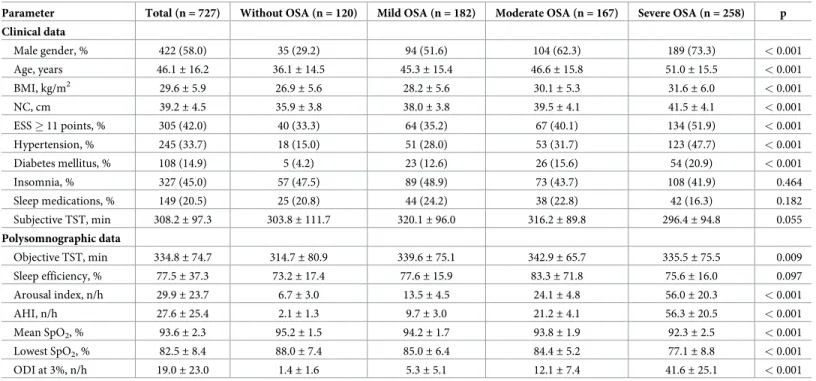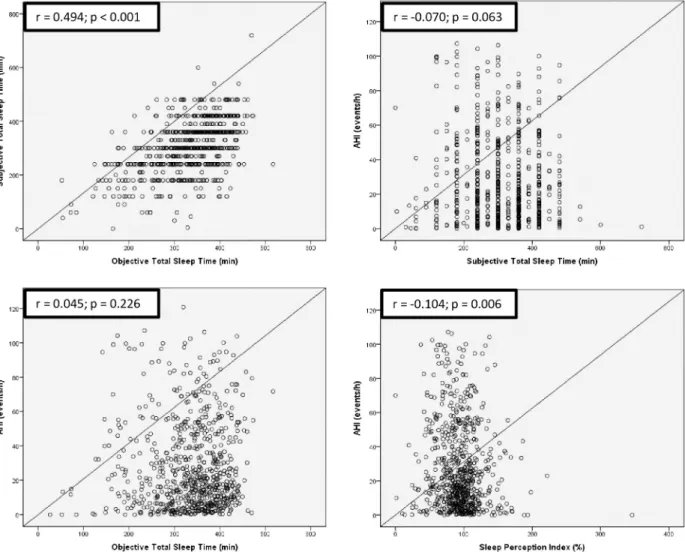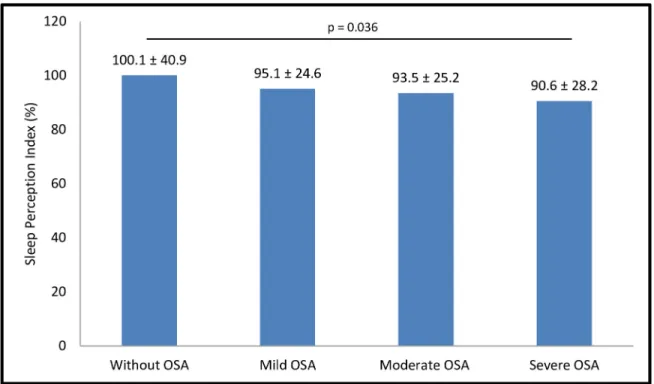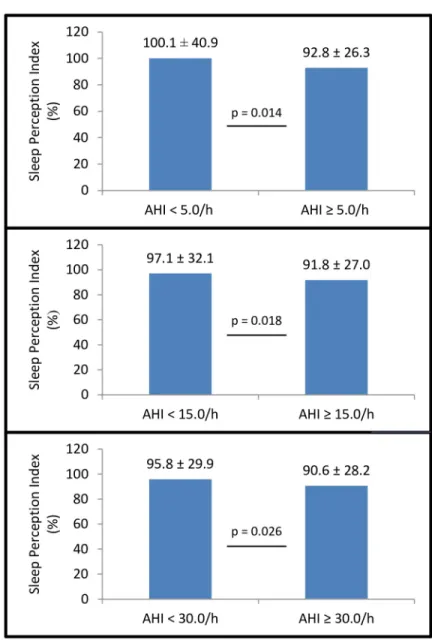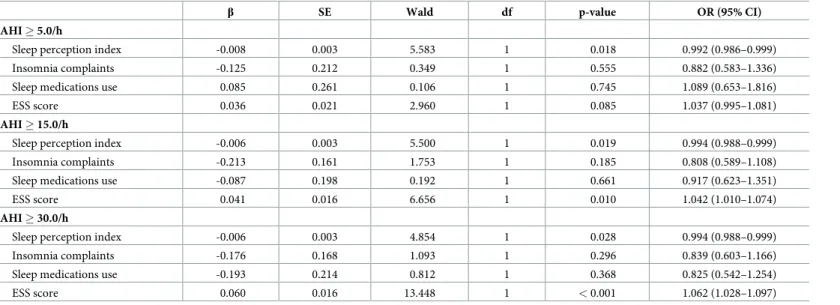RESEARCH ARTICLE
Perception of sleep duration in adult patients
with suspected obstructive sleep apnea
Ricardo L. M. Duarte1,2, Bruno A. Mendes3, Tiago S. Oliveira-e-Sa´3,4, Flavio J. Magalhã es-da-SilveiraID1, David GozalID5*
1 SleepLab - Laborato´ rio de Estudo dos Distu´rbios do Sono, Rio de Janeiro, Brazil, 2 Instituto de Doenc¸as do To´rax - Universidade Federal do Rio de Janeiro, Rio de Janeiro, Brazil, 3 Hospital de Santa Marta - Centro Hospitalar Universita´ rio Lisboa Central, Lisbon, Portugal, 4 NOVA Medical School - Faculdade de Ciências Me´dicas, Universidade Nova de Lisboa, Lisbon, Portugal, 5 Department of Child Health and Child Health Research Institute, University of Missouri School of Medicine, Columbia, Missouri, United States of America
*gozald@health.missouri.edu
Abstract
Purpose
Discrepancies between subjective and objective measures of total sleep time (TST) are fre-quent among insomnia patients, but this issue remains scarcely investigated in obstructive sleep apnea (OSA). We aimed to evaluate if sleep perception is affected by the severity of OSA.
Methods
We performed a 3-month cross-sectional study of Brazilian adults undergoing overnight polysomnography (PSG). TST was objectively assessed from PSG and by a self-reported questionnaire (subjective measurement). Sleep perception index (SPI) was defined by the ratio of subjective and objective values. Diagnosis of OSA was based on an apnea/hypop-nea index (AHI)�5.0/h, being its severity classified according to AHI thresholds: 5.0–14.9/h (mild OSA), 15.0–29.9/h (moderate OSA), and�30.0/h (severe OSA).
Results
Overall, 727 patients were included (58.0% males). A significant difference was found in SPI between non-OSA and OSA groups (p = 0.014). Mean SPI values significantly decreased as the OSA severity increased: without OSA (100.1±40.9%), mild OSA (95.1±24.6%), moderate OSA (93.5±25.2%), and severe OSA (90.6±28.2%), p = 0.036. Using logistic regression, increasing SPI was associated with a reduction in the likelihood of presenting any OSA (p = 0.018), moderate/severe OSA (p = 0.019), and severe OSA (p = 0.028). How-ever, insomnia was not considered as an independent variable for the presence of any OSA, moderate/severe OSA, and severe OSA (all p-values>0.05).
Conclusion
In a clinical referral cohort, SPI significantly decreases with increasing OSA severity, but is not modified by the presence of insomnia symptoms.
a1111111111 a1111111111 a1111111111 a1111111111 a1111111111 OPEN ACCESS
Citation: Duarte RLM, Mendes BA, Oliveira-e-Sa´ TS, Magalhães-da-Silveira FJ, Gozal D (2020) Perception of sleep duration in adult patients with suspected obstructive sleep apnea. PLoS ONE 15 (8): e0238083.https://doi.org/10.1371/journal. pone.0238083
Editor: James Andrew Rowley, Harper University Hospital, UNITED STATES
Received: June 19, 2020 Accepted: August 10, 2020 Published: August 27, 2020
Peer Review History: PLOS recognizes the benefits of transparency in the peer review process; therefore, we enable the publication of all of the content of peer review and author responses alongside final, published articles. The editorial history of this article is available here: https://doi.org/10.1371/journal.pone.0238083 Copyright:© 2020 Duarte et al. This is an open access article distributed under the terms of the Creative Commons Attribution License, which permits unrestricted use, distribution, and reproduction in any medium, provided the original author and source are credited.
Data Availability Statement: All relevant data are within the paper and its Supporting Information files.
Introduction
Obstructive sleep apnea (OSA) is an extremely prevalent disorder [1], characterized by repeti-tive complete or partial airflow limitation due to increases in upper airway resistance during sleep, leading to intermittent hypoxemia and sleep fragmentation [2]. These hallmark charac-teristics of OSA are associated with cardiovascular, metabolic, and neurocognitive morbidities [2–5]. Diagnosis and assessment of OSA severity are based on the overnight polysomno-graphic study and routinely rely on the apnea-hypopnea index (AHI), which consists of the sum of apneas and hypopneas per hour of sleep. Although OSA is a frequent disease and is associated with high morbidity, it remains underdiagnosed [6,7], especially due to the limited access, primarily in regions with scarce financial resources. Therefore, in adult individuals, portable home tests have quickly emerged as an alternative and effective method for the diag-nosis of OSA, particularly in light of their reduced cost and wider availability when compared to full polysomnography (PSG) [8].
Another highly prevalent sleep disorder is chronic insomnia, and according to the defini-tion used, insomnia rates can reach up to about 50% [9–11]. In general, the clinical diagnosis of insomnia is based on the presence of specific symptoms and their duration. Symptoms asso-ciated with chronic insomnia are difficulty in initiating sleep, difficulty maintaining sleep, and waking up earlier than desired, with one or more of such symptoms being present for at least 3 months [9–11]. Patients suffering from insomnia are more likely to use sleep medications, in addition to reporting more fragmented sleep and fewer total hours of sleep than those without a diagnosis of insomnia [9–11].
A mismatch between subjective data (patient complaints) and objective measurements col-lected from PSG may be related to fragmented sleep, which is more frequently present among patients with chronic insomnia than in patients with OSA and/or in the general population [12–22]. Among patients with insomnia, an overestimation of sleep latency and an underesti-mation of total sleep time (TST) are often observed [12–21]. In contrast, patients with OSA appear to have relative preservation of sleep perception (SP), whereas SP is worse in insomnia [21].
However, among symptomatic individuals being referred to the sleep laboratory for sus-pected OSA, a large cluster of comorbid OSA-insomnia is present [22–24], which may, there-fore, change SP in OSA depending on the proportion of OSA-insomnia in the cohort. Studies focusing on SP concerning different levels of OSA severity are also scarce and available litera-ture has focused on OSA as a dichotomous variable rather than explore the severity of OSA as a modifier. In the present study, we hypothesized that as OSA severity increases in clinically referred symptomatic patients, SP will be affected and that this effect may be independent of concurrent insomnia symptoms.
Materials and methods
Study design and patient selection
This cross-sectional study was carried out between December 2019 and February 2020. All participants were referred for sleep evaluation due to suspected sleep-disordered breathing by their attending physicians. Inclusion criteria consisted of individuals aged 18 years and older and with suspected OSA. Exclusion criteria were as follows: previously diagnosed OSA, use of home sleep studies for diagnosis, and incomplete clinical data concerning the absence of one or more of the following parameters: subjective analysis of TST, insomnia symptoms, use of sleeping medications, and/or Epworth Sleepiness Scale (ESS). Subsequently, eligible Funding: The author(s) received no specific
funding for this work.
Competing interests: The authors have declared that no competing interests exist.
individuals who underwent PSG and were diagnosed with central sleep apnea or those whose PSG was technically inadequate were also excluded from analyses.
Ethics statement
The study protocol (#1.764.165) was approved by the Research Ethics Committee of the Fed-eral University of Rio de Janeiro and was carried out by the ethical standards laid down in the 1964 Declaration of Helsinki and its later amendments. All participants gave written informed consent before any study procedure. The anonymity of each subject was strictly preserved.
Clinical data acquisition
On the evening of the PSG and after collecting the consent form, gender, age, body mass index (BMI), neck circumference (NC), ESS, self-reported comorbidities (hypertension, diabetes mellitus, and insomnia), and regular use of sleep medications were systematically collected by experienced sleep technicians. BMI was calculated by dividing the weight in kilograms by the square of the height in meters (kg/m2). NC (in cm) was measured using a flexible tape with all subjects in the upright sitting position, with the upper edge of the tape measure placed imme-diately below the laryngeal prominence and applied perpendicularly to the long axis of the neck. Subjective sleepiness was assessed using ESS, an 8-item questionnaire, with four-point scales [from zero to three] [25]. Score � 11 points (final score from 0 to 24 points) was consid-ered as excessive daytime somnolence [25].
Chronic insomnia was defined as present if a patient indicated one or more of the following complaints, which were investigated through a semi-structured interview immediately before PSG: difficulty falling asleep, difficulty maintaining sleep, and/or waking up earlier than desired. Furthermore, these symptoms needed to occur at least 3 nights a week for � 3 months and to be related to the presence of functional daytime impairments [26].
Overnight in-lab polysomnography
All sleep tests were conducted in a single-center:SleepLab—Laboratório de Estudo dos Distúr-bios do Sono, Rio de Janeiro in Brazil. All participants underwent an attended, in-lab full PSG
(EMBLA1S7000, Embla Systems, Inc., Broomfield, CO, USA) consisting of the recording of electroencephalography, electrooculography, electromyography (chin and legs), electrocardi-ography, airflow, thoracic and abdominal impedance belts, oxygen saturation, microphone for snoring, and body position sensors. Polysomnographic data were scored manually following the latest 2012 American Academy of Sleep Medicine guidelines [27] by two board-certified sleep physicians, who were blind to the results of the estimated TST measurements.
Obstructive apneas were defined as a decrease of at least 90% of airflow from baseline with persistent respiratory effort, lasting at least 10 seconds [27]. Hypopneas were classified as a reduction in the respiratory signal � 30% lasting � 10 seconds that were associated with � 3% oxygen desaturation or arousal [27]. The AHI was calculated as the combined number of apnea and hypopnea episodes per hour sleep. Polysomnographic diagnosis of OSA was based on AHI � 5.0/h, being its severity classified according to AHI thresholds: � 5.0/h as any OSA, � 15.0/h as moderate/severe OSA, and � 30.0/h as severe OSA.
Sleep perception index calculation
The next morning after PSG, all volunteers were asked to complete a questionnaire about their sleep study satisfaction and to estimate the subjective TST (min). (S1 File) Objective TST (min) was assessed from overnight PSG. Then, the sleep perception index (SPI) was calculated
as the ratio between the subjective TST estimate and the corresponding objective TST mea-surement [28].
Statistical analysis
Data analysis was carried out using Statistical Package for the Social Sciences for Windows (SPSS; version 21.0; Chicago, IL, USA). Results are summarized as mean± standard deviation or as number and percentage for continuous and categorical variables; respectively. Compari-sons between groups were performed using the chi-squared test for categorical variables, while continuous variables were assessed using Student’st-test or univariate analysis of variance
(ANOVA). Correlation was calculated through the Spearman’s coefficient (r). Binary logistic regression was used to predict the relationship between predictors (SPI, presence of insomnia complaints, regular use of sleep-promoting medications, and ESS) and a dependent variable (AHI � 5.0versus < 5.0/h, � 15.0 versus < 15.0/h, or � 30.0 versus < 30.0/h). Estimates from
logistic regression tests were expressed as odds ratios (OR) with the respective 95% confidence interval (CI). Calibration was evaluated by Hosmer-Lemeshow chi-squared test, being p < 0.05 considered as poor calibration [29]. Statistical tests were two-tailed and statistical sig-nificance was set at p < 0.05.
Results
Of a total of 794 consecutive subjects referred for diagnostic PSG, 67 patients (8.4%) were sub-sequently excluded for the following reasons: 60 with incomplete clinical data, 5 tested with portable sleep studies, and 2 with previously diagnosed OSA. Therefore, a total of 727 adult individuals—including 422 males (58.0%) and 305 females (42.0%)—were considered eligible for further analyses. No PSG needed to be repeated.
Baseline patient characteristics are reported inTable 1. Overall, the mean age was 46.1± 16.2 years, mean BMI was 29.6 ± 5.9 kg/m2, and mean NC was 39.2± 4.5 cm. As OSA severity increased, there was a proportional increase in the percentage of male individuals, in addition to increases in age, BMI, NC, presence of hypertension and diabetes, and excessive daytime sleepiness (p < 0.001 for all variables;Table 1). As would be expected in light of the inclusion of individuals with a high OSA pretest probability, there was a high frequency of any OSA (83.5%), moderate/severe OSA (58.5%), and severe OSA (35.5%).
Sleep perception
Fig 1illustrates the scatterplots between TST (subjective and objective measurements), SPI, and AHI. There was a positive correlation between subjective and objective values of TST (p < 0.001). Conversely, neither subjective TST nor objective TST was significantly associated with AHI: p-values: 0.063 and 0.226, respectively. Additionally, SPI was negatively correlated with AHI (p = 0.006).
As reported inFig 2, mean SPI measurements were statistically different across OSA sever-ity categories based on AHI: < 5.0/h, 5.0–14.9/h, 15.0–29.9/h, and � 30.0/h; p = 0.036. Con-versely, frequency of insomnia complaints was similar in patients classified according to OSA severity categories based on AHI thresholds: < 5.0/h (47.5%), 5.0–14.9/h (48.9%), 15.0–29.9/h (43.7%), and � 30.0/h (41.9%), p = 0.464.
As shown inFig 3, mean SPI values were statistically different according to three AHI cut-off points: < 5.0/hversus � 5.0/h (p = 0.014); < 15.0/h versus � 15.0/h (p = 0.018);
and < 30.0/hversus � 30.0/h (p = 0.026). On the other hand, frequency of insomnia symptoms
versus � 5.0/h (44.5%), p = 0.549; < 15.0/h (48.3%) versus � 15.0/h (42.6%), p = 0.131;
and < 30.0/h (46.7%)versus � 30.0/h (41.9%), p = 0.214.
Of note, only males showed a statistically significant reduction in mean SPI values as the severity of OSA increased: SPI ranged from 109.3± 50.5% (without OSA) to 88.1 ± 26.6% (severe OSA), p < 0.001. In females, however, SPI was similar concerning increasing AHI-based categories, ranging from 96.3± 36.0% (without OSA) to 97.8 ± 31.4% (severe OSA), p = 0.935.
Binary logistic regression
Table 2shows the logistic regression that was performed to verify the effects of SPI, insomnia symptoms, regular use of sleep-promoting medications, and ESS on the likelihood of individu-als having any OSA, moderate/severe OSA, and severe OSA. Increasing SPI was associated with a reduction in the likelihood of presenting any OSA (OR: 0.992 [95% CI: 0.986–0.999]; p = 0.018), moderate/severe OSA (OR: 0.994 [95% CI: 0.988–0.999]; p = 0.019), and severe OSA (OR: 0.994 [95% CI 0.988–0.999]; p = 0.028). Increasing the ESS score was associated with a higher probability of exhibiting moderate/severe OSA (p = 0.010) and severe OSA (p < 0.001). Also, neither the presence of insomnia nor the regular use of sleep-promoting medications was considered as an independent variable for the presence of any OSA, moder-ate/severe OSA, and severe OSA (all p-values > 0.05).
Table 1. Patient characteristics (n = 727).
Parameter Total (n = 727) Without OSA (n = 120) Mild OSA (n = 182) Moderate OSA (n = 167) Severe OSA (n = 258) p Clinical data Male gender, % 422 (58.0) 35 (29.2) 94 (51.6) 104 (62.3) 189 (73.3) < 0.001 Age, years 46.1± 16.2 36.1± 14.5 45.3± 15.4 46.6± 15.8 51.0± 15.5 < 0.001 BMI, kg/m2 29.6± 5.9 26.9± 5.6 28.2± 5.6 30.1± 5.3 31.6± 6.0 < 0.001 NC, cm 39.2± 4.5 35.9± 3.8 38.0± 3.8 39.5± 4.1 41.5± 4.1 < 0.001 ESS � 11 points, % 305 (42.0) 40 (33.3) 64 (35.2) 67 (40.1) 134 (51.9) < 0.001 Hypertension, % 245 (33.7) 18 (15.0) 51 (28.0) 53 (31.7) 123 (47.7) < 0.001 Diabetes mellitus, % 108 (14.9) 5 (4.2) 23 (12.6) 26 (15.6) 54 (20.9) < 0.001 Insomnia, % 327 (45.0) 57 (47.5) 89 (48.9) 73 (43.7) 108 (41.9) 0.464 Sleep medications, % 149 (20.5) 25 (20.8) 44 (24.2) 38 (22.8) 42 (16.3) 0.182 Subjective TST, min 308.2± 97.3 303.8± 111.7 320.1± 96.0 316.2± 89.8 296.4± 94.8 0.055 Polysomnographic data Objective TST, min 334.8± 74.7 314.7± 80.9 339.6± 75.1 342.9± 65.7 335.5± 75.5 0.009 Sleep efficiency, % 77.5± 37.3 73.2± 17.4 77.6± 15.9 83.3± 71.8 75.6± 16.0 0.097 Arousal index, n/h 29.9± 23.7 6.7± 3.0 13.5± 4.5 24.1± 4.8 56.0± 20.3 < 0.001 AHI, n/h 27.6± 25.4 2.1± 1.3 9.7± 3.0 21.2± 4.1 56.3± 20.5 < 0.001 Mean SpO2, % 93.6± 2.3 95.2± 1.5 94.2± 1.7 93.8± 1.9 92.3± 2.5 < 0.001 Lowest SpO2, % 82.5± 8.4 88.0± 7.4 85.0± 6.4 84.4± 5.2 77.1± 8.8 < 0.001 ODI at 3%, n/h 19.0± 23.0 1.4± 1.6 5.3± 5.1 12.1± 7.4 41.6± 25.1 < 0.001
Data were presented as mean± standard deviation or n (%). BMI: body-mass index; NC: neck circumference; ESS: Epworth Sleepiness Scale; TST: total sleep time; AHI: apnea/hypopnea index; SpO2: oxygen saturation; ODI: oxygen desaturation index. TST was objectively evaluated from PSG, while its subjective measure was filled out
using a questionnaire. Polysomnographic diagnosis of obstructive sleep apnea (OSA) was based on AHI thresholds: < 5.0/h (without OSA), 5.0–14.9/h (mild OSA), 15.0–29.9/h (moderate OSA), and � 30.0/h (severe OSA).
Discussion
The main findings of our study were that SPI values progressively decreased with increasing severity of OSA, indicating that individuals with more severe forms of OSA tend to have a worse SP. It is therefore likely that the increasing severity of OSA manifesting both as more severe intermittent hypoxemia (increased oxygen desaturation index) and sleep fragmentation (increased arousal index) may induce progressive sleep satisfaction reductions [21,30–32]. We further explore whether concurrent insomnia-related symptoms could have affected our find-ings since individuals with insomnia noticeably have a lower SPI when compared with OSA patients or controls [12–20]. As the frequency of insomnia complaints was similar across the AHI categorical thresholds (5.0/h, 15.0/h, and 30.0/h), the presence or absence of insomnia is highly unlikely to have biased our findings. Moreover, this parameter was not considered as an independent variable for the diagnosis of OSA, regardless of its severity (all p-values > 0.05).
Unlike our findings, a previous study that included 248 individuals (42% without OSA and 58% with OSA) reported no differences in the objective and subjective measures of TST in Fig 1. Scatterplot of Apnea/Hypopnea Index (AHI), subjective and objective Total Sleep Time (TST), and Sleep Perception Index (SPI) in 727 individuals. Subjective TST value was self-reported by participants, while objective TST value was measured from full polysomnography. SPI was defined as the ratio between the subjective and objective TST. Spearman’s rank correlation coefficient (r) was used to evaluate the strength of association between two variables.
patients diagnosed with OSA [20]. However, this study defined only one AHI threshold at 5.0/ h to categorize patients with or without OSA, while we expanded the analysis to a larger cohort of subjects and applied the three AHI thresholds most commonly used to assess OSA severity. This approach revealed that SP was significantly reduced with the concomitant increase in OSA severity, but found no significant association with the frequency of comorbid OSA-insomnia.
Another study postulated that compared with patients diagnosed with mild OSA, those diagnosed with severe OSA would exhibit greater sleep fragmentation, which in turn could lead to a worse SP [32]. This study enrolled 50 OSA patients which included 30 with normal SP and 20 with abnormal SP, i.e., perceived TST < 80% of TST measured in PSG [32]. No sta-tistically significant difference in SP emerged based on different OSA severities: 0.75± 0.21 (mild OSA), 0.89± 0.18 (moderate OSA), and 0.82 ± 0.20 (severe OSA); p = 0.19 (32). How-ever, the small size sample, the use of the 2007 American Academy of Sleep Medicine scoring criteria, and the absence of controls (subjects without OSA) are all substantial limitations that may account for the negative findings [32].
In our study, men, but not women, showed a statistically significant reduction in mean SPI measurements as the severity of OSA increased. This finding, although intriguing, should be extrapolated to the general population with caution, since men are more likely to suffer OSA than women, while women typically are more likely to present with increased insomnia symp-toms when compared to men. Moreover, other covariates, such as age and BMI, should also be concurrently evaluated to establish whether there are SP differences between men and women, or whether these are only the result of the enrolled population.
Fig 2. Sleep Perception Index (SPI) and Obstructive Sleep Apnea (OSA) severity. SPI measurements were statistically different across categories of OSA severities: < 5.0/h (without OSA), 5.0–14.9/h (mild OSA), 15.0–29.9/h (moderate OSA), and � 30.0/h (severe OSA). SPI was defined as the ratio between the subjective and objective total sleep time. Values were reported as mean± standard deviation. https://doi.org/10.1371/journal.pone.0238083.g002
Limitations and strengths
Our study had some limitations that deserve mention. All participants were referred to a single sleep laboratory, which may limit the reproducibility and generalization of our findings. Other measures of SP commonly evaluated mainly in individuals suffering from insomnia, such as sleep latency and awakenings, were not included, but since the prevalence of insomnia was similar across OSA severity groups, the impact of such omission should be minimal if any. Another possible limitation was that the objective measurement of TST was extracted exclu-sively from a single night in the sleep laboratory; therefore, night-to-night variability or the effects of the first night could not be completely excluded. However, the inclusion of a rela-tively robust sample of consecutive adult individuals who underwent full in-lab PSGs is an Fig 3. Sleep Perception Index (SPI) and Apnea/Hypopnea Index (AHI) thresholds. SPI measurements were statistically different according to three AHI thresholds: < 5.0/hversus � 5.0/h, < 15.0/h versus � 15.0/h, and < 30.0 versus � 30.0/h. SPI was defined as the ratio between the subjective and objective total sleep time. Values were shown
as mean± standard deviation.
obvious strength of the present study. Moreover, both physicians responsible for PSG reports were blinded to the subjective TST estimate values.
Conclusions
In symptomatic adults who are clinically referred to a sleep laboratory, SPI was lower in those subjects with OSA diagnosis. Furthermore, among those diagnosed with OSA, SPI decreased according to the severity of OSA increased, and this relationship was not influenced by the presence of clinical symptoms of insomnia.
Supporting information
S1 File. (DOCX)
Author Contributions
Conceptualization: Ricardo L. M. Duarte, Bruno A. Mendes, Flavio J. Magalhães-da-Silveira. Data curation: Ricardo L. M. Duarte, Bruno A. Mendes.
Formal analysis: Ricardo L. M. Duarte.
Investigation: Ricardo L. M. Duarte, Bruno A. Mendes.
Methodology: Ricardo L. M. Duarte, Bruno A. Mendes, Tiago S. Oliveira-e-Sa´, Flavio J. Magalhães-da-Silveira, David Gozal.
Project administration: Flavio J. Magalhães-da-Silveira, David Gozal. Writing – original draft: Ricardo L. M. Duarte.
Table 2. Binary logistic regression of covariates according to AHI thresholds (n = 727).
β SE Wald df p-value OR (95% CI)
AHI � 5.0/h
Sleep perception index -0.008 0.003 5.583 1 0.018 0.992 (0.986–0.999)
Insomnia complaints -0.125 0.212 0.349 1 0.555 0.882 (0.583–1.336)
Sleep medications use 0.085 0.261 0.106 1 0.745 1.089 (0.653–1.816)
ESS score 0.036 0.021 2.960 1 0.085 1.037 (0.995–1.081)
AHI � 15.0/h
Sleep perception index -0.006 0.003 5.500 1 0.019 0.994 (0.988–0.999)
Insomnia complaints -0.213 0.161 1.753 1 0.185 0.808 (0.589–1.108)
Sleep medications use -0.087 0.198 0.192 1 0.661 0.917 (0.623–1.351)
ESS score 0.041 0.016 6.656 1 0.010 1.042 (1.010–1.074)
AHI � 30.0/h
Sleep perception index -0.006 0.003 4.854 1 0.028 0.994 (0.988–0.999)
Insomnia complaints -0.176 0.168 1.093 1 0.296 0.839 (0.603–1.166)
Sleep medications use -0.193 0.214 0.812 1 0.368 0.825 (0.542–1.254)
ESS score 0.060 0.016 13.448 1 < 0.001 1.062 (1.028–1.097)
AHI: apnea/hypopnea index; ESS: Epworth Sleepiness Scale,β: regression coefficient, SE: standard error, df: degrees of freedom for the Wald test, OR: odds ratio, CI: confidence interval. Sleep perception index was defined as the ratio between the subjective and objective total sleep time. The logistic model regression model showed adequate calibration, which was accessed by Hosmer–Lemeshow test: any OSA (AHI � 5.0/h): 8.987 (p = 0.343); moderate/severe OSA (AHI � 15.0/h): 14.572 (p = 0.068); and severe OSA (AHI � 30.0/h): 4.754 (p = 0.783).
Writing – review & editing: Ricardo L. M. Duarte, Bruno A. Mendes, Tiago S. Oliveira-e-Sa´, Flavio J. Magalhães-da-Silveira, David Gozal.
References
1. Benjafield AV, Ayas NT, Eastwood PR, Heinzer R, Ip MSM, Morrell MJ, et al. Estimation of the global prevalence and burden of obstructive sleep apnoea: a literature-based analysis. Lancet Respir Med. 2019; 7(8):687–98. Epub 2019 Jul 9.https://doi.org/10.1016/S2213-2600(19)30198-5PMID:
31300334;.
2. Kapur VK, Auckley DH, Chowdhuri S, Kuhlmann DC, Mehra R, Ramar K, et al. Clinical Practice Guide-line for Diagnostic Testing for Adult Obstructive Sleep Apnea: An American Academy of Sleep Medicine Clinical Practice Guideline. J Clin Sleep Med. 2017; 13(3):479–504.https://doi.org/10.5664/jcsm.6506
PMID:28162150;.
3. Mokhlesi B, Ham SA, Gozal D. The effect of sex and age on the comorbidity burden of OSA: an obser-vational analysis from a large nationwide US health claims database. Eur Respir J. 2016; 47(4):1162–9. Epub 2016 Jan 21.https://doi.org/10.1183/13993003.01618-2015PMID:26797029.
4. Martı´nez Cero´n E, Casitas Mateos R, Garcı´a-Rı´o F. Sleep apnea-hypopnea syndrome and type 2 dia-betes. A reciprocal relationship? Arch Bronconeumol. 2015; 51(3):128–39. Epub 2014 Aug 18.https:// doi.org/10.1016/j.arbres.2014.06.017PMID:25145320.
5. Kendzerska T, Gershon AS, Hawker G, Leung RS, Tomlinson G. Obstructive sleep apnea and risk of cardiovascular events and all-cause mortality: a decade-long historical cohort study. PLoS Med. 2014; 11(2):e1001599.https://doi.org/10.1371/journal.pmed.1001599PMID:24503600;.
6. Kapur V, Strohl KP, Redline S, Iber C, O’Connor G, Nieto J. Underdiagnosis of sleep apnea syndrome in U.S. communities. Sleep Breath. 2002; 6(2):49–54.https://doi.org/10.1007/s11325-002-0049-5
PMID:12075479.
7. Fuhrman C, Fleury B, Nguyên XL, Delmas MC. Symptoms of sleep apnea syndrome: high prevalence and underdiagnosis in the French population. Sleep Med. 2012; 13(7):852–8. Epub 2012 Jun 15.
https://doi.org/10.1016/j.sleep.2012.04.005PMID:22705245.
8. Collop NA, Anderson WM, Boehlecke B, Claman D, Goldberg R, Gottlieb DJ, et al. Clinical guidelines for the use of unattended portable monitors in the diagnosis of obstructive sleep apnea in adult patients. Portable Monitoring Task Force of the American Academy of Sleep Medicine. J Clin Sleep Med. 2007; 3 (7):737–47. PMID:18198809;.
9. Ohayon MM. Epidemiology of insomnia: what we know and what we still need to learn. Sleep Med Rev. 2002; 6(2):97–111.https://doi.org/10.1053/smrv.2002.0186PMID:12531146.
10. Chung KF. Insomnia subtypes and their relationships to daytime sleepiness in patients with obstructive sleep apnea. Respiration. 2005; 72(5):460–5.https://doi.org/10.1159/000087668PMID:16210883. 11. Krell SB, Kapur VK. Insomnia complaints in patients evaluated for obstructive sleep apnea. Sleep
Breath. 2005; 9(3):104–10.https://doi.org/10.1007/s11325-005-0026-xPMID:16091954.
12. Bianchi MT, Williams KL, McKinney S, Ellenbogen JM. The subjective-objective mismatch in sleep per-ception among those with insomnia and sleep apnea. J Sleep Res. 2013; 22(5):557–68. Epub 2013 Mar 25.https://doi.org/10.1111/jsr.12046PMID:23521019.
13. Fernandez-Mendoza J, Calhoun SL, Bixler EO, Karataraki M, Liao D, Vela-Bueno A, et al. Sleep mis-perception and chronic insomnia in the general population: role of objective sleep duration and psycho-logical profiles. Psychosom Med. 2011; 73(1):88–97. Epub 2010 Oct 26.https://doi.org/10.1097/PSY. 0b013e3181fe365aPMID:20978224;.
14. Manconi M, Ferri R, Sagrada C, Punjabi NM, Tettamanzi E, Zucconi M, et al. Measuring the error in sleep estimation in normal subjects and in patients with insomnia. J Sleep Res. 2010; 19(3):478–86. Epub 2010 Feb 10.https://doi.org/10.1111/j.1365-2869.2009.00801.xPMID:20149068.
15. Means MK, Edinger JD, Glenn DM, Fins AI. Accuracy of sleep perceptions among insomnia sufferers and normal sleepers. Sleep Med. 2003; 4(4):285–96.https://doi.org/10.1016/s1389-9457(03)00057-1
PMID:14592301.
16. Castillo J, Goparaju B, Bianchi MT. Sleep-wake misperception in sleep apnea patients undergoing diag-nostic versus titration polysomnography. J Psychosom Res. 2014; 76(5):361–7. Epub 2014 Mar 22.
https://doi.org/10.1016/j.jpsychores.2014.03.001PMID:24745776;.
17. Choi SJ, Suh S, Ong J, Joo EY. Sleep Misperception in Chronic Insomnia Patients with Obstructive Sleep Apnea Syndrome: Implications for Clinical Assessment. J Clin Sleep Med. 2016; 12(11):1517– 25.https://doi.org/10.5664/jcsm.6280PMID:27568893;.
18. Trajanovic NN, Radivojevic V, Kaushansky Y, Shapiro CM. Positive sleep state misperception—a new concept of sleep misperception. Sleep Med. 2007; 8(2):111–8. Epub 2007 Feb 1.https://doi.org/10. 1016/j.sleep.2006.08.013PMID:17275407.
19. Schinkelshoek MS, de Wit K, Bruggink V, Fronczek R, Lammers GJ. Daytime sleep state misperception in a tertiary sleep centre population. Sleep Med. 2020; 69:78–84. Epub 2020 Jan 10.https://doi.org/10. 1016/j.sleep.2019.12.026PMID:32058230.
20. Laranjeira CM, Barbosa ERF, Rabahi MF. Is subjective sleep evaluation a good predictor for obstructive sleep apnea? Clinics (Sao Paulo). 2018; 73:e355.https://doi.org/10.6061/clinics/2018/e355PMID:
30020341;.
21. Pinto LR Jr, Pinto MC, Goulart LI, Truksinas E, Rossi MV, Morin CM, et al. Sleep perception in insomni-acs, sleep-disordered breathing patients, and healthy volunteers—an important biologic parameter of sleep. Sleep Med. 2009; 10(8):865–8. Epub 2009 Jan 28.https://doi.org/10.1016/j.sleep.2008.06.016
PMID:19179110.
22. Lubetkin EI, Jia H. Burden of disease due to sleep duration and sleep problems in the elderly. Sleep Health. 2018; 4(2):182–187. Epub 2018 Jan 17.https://doi.org/10.1016/j.sleh.2017.11.007PMID:
29555132.
23. Eysteinsdottir B, Gislason T, Pack AI, Benediktsdottir B, Arnardottir ES, Kuna ST, et al. Insomnia com-plaints in lean patients with obstructive sleep apnea negatively affect positive airway pressure treatment adherence. J Sleep Res. 2017; 26(2):159–165. Epub 2016 Dec 15.https://doi.org/10.1111/jsr.12482
PMID:27976438;.
24. Pien GW, Ye L, Keenan BT, Maislin G, Bjo¨rnsdo´ttir E, Arnardottir ES, et al. Changing Faces of Obstruc-tive Sleep Apnea: Treatment Effects by Cluster Designation in the Icelandic Sleep Apnea Cohort. Sleep. 2018; 41(3):zsx201.https://doi.org/10.1093/sleep/zsx201PMID:29301021;
25. Johns MW. A new method for measuring daytime sleepiness: the Epworth sleepiness scale. Sleep. 1991; 14(6):540–5.https://doi.org/10.1093/sleep/14.6.540PMID:1798888.
26. Sateia MJ. International classification of sleep disorders-third edition: highlights and modifications. Chest. 2014; 146(5):1387–1394.https://doi.org/10.1378/chest.14-0970PMID:25367475. 27. Berry RB, Budhiraja R, Gottlieb DJ, Gozal D, Iber C, Kapur VK, et al. Rules for scoring respiratory
events in sleep: update of the 2007 AASM Manual for the Scoring of Sleep and Associated Events. Deliberations of the Sleep Apnea Definitions Task Force of the American Academy of Sleep Medicine. J Clin Sleep Med. 2012; 8(5):597–619.https://doi.org/10.5664/jcsm.2172PMID:23066376;.
28. Edinger JD, Fins AI. The distribution and clinical significance of sleep time misperceptions among insomniacs. Sleep. 1995; 18(4):232–9.https://doi.org/10.1093/sleep/18.4.232PMID:7618020. 29. Steyerberg EW, Vickers AJ, Cook NR, Gerds T, Gonen M, Obuchowski N, et al. Assessing the
perfor-mance of prediction models: a framework for traditional and novel measures. Epidemiology. 2010; 21 (1):128–38.https://doi.org/10.1097/EDE.0b013e3181c30fb2PMID:20010215;.
30. Ohayon MM, Chen MC, Bixler E, Dauvilliers Y, Gozal D, Plazzi G, et al. A provisional tool for the mea-surement of sleep satisfaction. Sleep Health. 2018; 4(1):6–12. Epub 2017 Dec 18.https://doi.org/10. 1016/j.sleh.2017.11.002PMID:29332682.
31. Ohayon MM, Paskow M, Roach A, Filer C, Hillygus DS, Chen MC, et al. The National Sleep Founda-tion’s Sleep Satisfaction Tool. Sleep Health. 2019; 5(1):5–11. Epub 2018 Oct 19.https://doi.org/10. 1016/j.sleh.2018.10.003PMID:30670166.
32. Nam H, Lim JS, Kim JS, Lee KJ, Koo DL, Lee C. Sleep Perception in Obstructive Sleep Apnea: A Study Using Polysomnography and the Multiple Sleep Latency Test. J Clin Neurol. 2016; 12(2):230–5.https:// doi.org/10.3988/jcn.2016.12.2.230PMID:27074296;.
